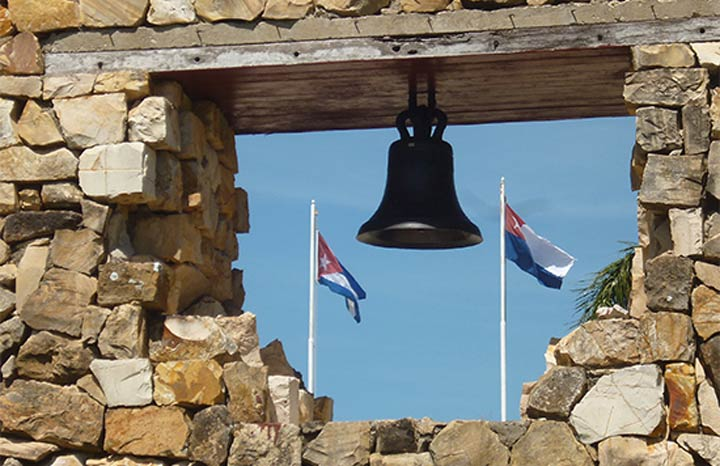
Havana, October 10.- In the early morning of October 10, 1868, the bell of the Demajagua sugarcane mill rang loudly and the slaves coincided in the square with free men, peasants and people from the city and heard the owner of the estate, Carlos Manuel de Céspedes, talk about war against Spain, about independence, about Homeland, but what those humble men understood most was that they were free and could participate or not in the independence feat, to which many joined.
That day, from early morning Céspedes organized the insurgent parties and gave orders to the improvised troops to prepare for the march, while at the same time he dedicated himself to preparing the manifesto that would announce to the world that Cubans were beginning the armed struggle for their freedom.
In the historic document he wrote: “No one ignores that Spain governs the island of Cuba with a bloody iron arm; Not only does it not leave the security in its properties, arrogating to itself the power to impose taxes and contributions at will, but having deprived Cuba of all political, civil and religious freedom, the country’s unfortunate children find themselves expelled from their soil to remote climes or executed without form of process, by military commissions established in full peace, with a decrease in civil power.”
He also established that democratic principles are those defended by patriots and the “imprescriptible rights of man,” and he advocated for the equality of all citizens, whether white or black, Cuban or Spanish.
He declared the freedom of his slaves and did not stop at any gradual emancipation as the manifesto proclaimed out of a tactical sense so as not to impress wealthy patriotic sectors, and set an important precedent that speaks of the radicality of his thought, much more advanced than that of their own social class.
But the harsh tests began for Céspedes when in the first encounter with the colonialist forces, the revolutionaries were dispersed, and only 12 men accompanied him. Faced with the surrender of some, he stood up on his horse and replied energetically: "No, there are still 12 men left! They are enough to achieve the independence of Cuba."
A few days later, the Mambí ranks regrouped again and the insurrection was consolidated throughout the East and center of the Island to begin the first Cuban independence war, which would last 10 years and in which the patriots, lacking the minimum resources in the countryside, they could only supply themselves with the weapons that they took from the enemy to establish a tradition that accompanied the mambises of '95 and the combatants of the Sierra Maestra in the last redemptive struggle.
With Demajagua and the other uprisings, the decision of sacrifice and intransigence of the most radical sectors of Cuban landowners to achieve independence at whatever price was necessary was evident, exemplified in the precursor figures of Carlos Manuel de Céspedes and Ignacio Agramonte, the which would not survive the fight they called and would fall in combat against the forces of the colonialist metropolis.
From the crucible of war a new vanguard would emerge among the popular classes, which by dint of heroism and blood and overcoming harsh circumstances would reach the highest ranks in the Liberation Army, such as the brothers Antonio and José Maceo, Máximo Gómez, Quintín Bandera, Guillermón Moncada, Calixto García, Serafín Sánchez and many others.
It would be José Martí, a young man of barely 16 years old when the conflagration broke out and who suffered imprisonment in Havana for his independence ideas, who would be in charge of leading a new stage of the independence deeds during almost 20 years of the so-called Fertile Truce that followed the Peace of Zanjón in 1878, which was reached due to internal divisions in the revolutionary ranks and which brought the end of the Ten Years' War.
Martí's crowning work would be to unite all Cuban patriots for the start of the Necessary War on February 24, 1895, in which he offered his life, leaving his legacy of patriotism, Latin Americanism and anti-imperialism that would guide the Cuban people for all time.
This idea of ??continuity and tribute to Martí and all the initiators of our national feat was completed by the Historical Leader of the Cuban Revolution, precisely in his memorable speech for the centenary of the feat on October 10, 1968 when he said:
(…) “What does this glorious date mean for the revolutionaries of our country? It simply means the beginning of a hundred years of struggle, the beginning of the revolution in Cuba, because in Cuba there has only been one revolution: the one that Carlos Manuel de Céspedes began on October 10, 1868 and that our people are carrying forward at this moment. ”
Those words are completely valid today because they explain the capacity for resistance and the ideals of the Cuban people who accompanied them during the 156 years that have passed since those memorable ringing of the bell with which Carlos Manuel de Céspedes called for the first fight for the independence of the Homeland. (Text and photo: ACN)